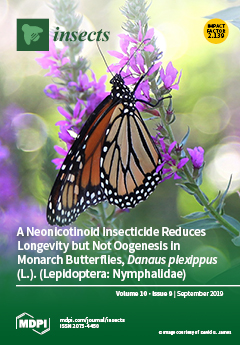We analysed electroantennogram (EAG) responses of male and female adults of the European grapevine moth
Lobesia botrana (Denis et Schiffermüller) (Lepidoptera: Tortricidae) collected as larvae from grapevine (
Vitis vinifera L.) and flax-leaved daphne (
Daphne gnidium L.). The host-plant odorants tested were
[...] Read more.
We analysed electroantennogram (EAG) responses of male and female adults of the European grapevine moth
Lobesia botrana (Denis et Schiffermüller) (Lepidoptera: Tortricidae) collected as larvae from grapevine (
Vitis vinifera L.) and flax-leaved daphne (
Daphne gnidium L.). The host-plant odorants tested were either
V. vinifera-specific [1-octen-3-ol, (
E)-β-farnesene, (
E)-4,8-dimethyl-1,3,7-nonatriene],
D. gnidium-specific (2-ethyl-hexan-1-ol, benzothiazole, linalool-oxide, ethyl benzanoate), or were shared by both host-plants (linalool, methyl salicylate). Sex pheromone compounds were also tested. The male response to the major pheromone component (
E7,
Z9-12:Ac) was higher than to any other stimuli, whereas the response to the minor pheromone components (
E7,
Z9-12:OH and
Z9-12:Ac) was not different from the response to the plant odorants. The female response to pheromone was lower or not different from that to plant odorants. Methyl salicylate elicited a higher response in females and (
E)-β-farnesene elicited a higher response than several other plant odorants in both sexes. Non-significant interactions between host-plant odorant and sex indicated an absence of sex specialization for host-plant volatile detection. The lack of a significant interaction between plant volatiles and larval host-plants suggested that there was no specialization for plant-volatile detection between
V. vinifera and
D. gnidium individuals.
Full article






